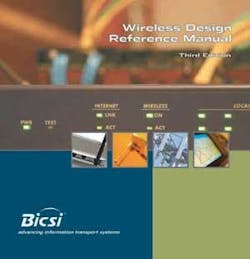Wireless design reference guide focuses on global best practices.
by Matt Vincent
In August, BICSI (www.bicsi.org) released its Wireless Design Reference Manual (WDRM), 3rd edition, designed to show information transport systems (ITS) professionals how to plan, design, and implement a wide spectrum of wireless telecommunications projects.
The premise of the WDRM, maintains BICSI, is that in today's communications world, wireless and cabling technologies increasingly must work hand–in–hand to provide the low–voltage information that many commercial building structures require. Aimed at designers, consultants, engineers, end users, and candidates for BICSI's Wireless Design (WD) specialty exam, the WDRM is billed as a carefully researched, vendor–neutral technical manual, precisely written to meet global best practices, and edited by key industry professionals who are referred to as Subject Matter Experts (SMEs).
This one's different
"The manual is really meant as a design reference, but one of the things that we tried to change was to gear it more towards the network side, because it is so different than any other BICSI manual," reflects Tony Whaley, RCDD, NTS, WD, CTS, vice president at RTKL Associates (www.rtkl.com), and BICSI's Technical Information and Methods (TI&M) committee WDRM subject matter expert team leader (SMETL).
"Everything within BICSI deals with the network, whereas this wireless manual covers everything from public safety radio to cellular communications, which is different from local area networks," Whaley adds. "That's why it's a bit more of a challenge to get that WD certification—one has to really sit down and study and know the information."
The WDRM contains: 822 pages with more than 233 figures and tables; a glossary of common wirelessindustry terms, symbols and acronyms; and an appendix covering international codes, standards, regulationsand organizations. The manual's 11 chapters are:Introduction to Wireless Design; Legal Aspects of Wireless Design; Project Management Basics; Overview of Wireless Fundamentals; Components of a Wireless System; General Wireless Design Considerations; Point–to–Point and Point–to–Multipoint Systems; Distributed Antenna Systems; Cellular and Paging Systems; Special Wireless Technologies; and Wireless Local AreaNetworks.
Wi–MAX, Wi–Fi focus
Especially, the third edition provides expandedinformation on emerging WiMAX and advancedWi–Fi networks, as well as distributed antennasystems (DAS).
"What I have seen is an increase in interest in distributed antenna systems to support wireless LAN and cellular technology, as well as public safety radio communications," says Whaley. "With 700 MHz coming out as a new licensed frequency, you're going to see public safety communications become more stabilized. Right now, within their wireless world, they operate in the UHF and VHF ranges as different frequencies. There's never been a common frequency for them to use, so that's why you had issues, like in 9/11, where some agencies couldn't talk to one another."
Whaley explains, "But now there are two types of frequencies that have been dedicated for public safety communications. There's the 700 MHz channel, which is UHF, which will allow all the different agencies to communicate, but it's also shared with commercial applications. In other words, it can make money by having a commercial application, but then during an emergency, it will be turned over to the publicsafety agencies that need it."
Whaley also attests to having seen significant recent interest in WiMAX and in–building cellular technologies, as well as other emerging wireless technologies.
"We talk about 4.9 GHz quite a bit—that's a microwave frequency that'll be used for backhaul communications, for point–to–point communications within buildings or emergency management agencies," he notes. "There's also 802.11y, another emerging wireless frequency that's coming to the forefront, and it's going to have different uses."
Regarding 802.11y, Whaley continues, "The good part about that [technology] is that it's licensed. The 2.4 GHz band isunlicensed, and in the manual, we talk about that and make a few recommendations—if you're going to use 2.4 Gig, you might want to look at using 5.8 as your backbone between your wireless systems, and then use 2.4 as, for lack of a better word, your horizontal, because of the fact that so manydevices run 2.4, and they're not controlled. They're unlicensed, and so you have to be careful about using them when you're laying out RF systems."
Designing in 3G
The third edition WDRM also introduces design best practices in 3G and pending 4G technology for IP–based wireless communications platforms integrating voice, data andmultimedia applications. Additionally, the manual coversinternational wireless regulations, codes and standards,components, design considerations, personal area networks (PANs), LANs, and systems that include point–to–point (PTP), point–to–multipoint, DAS, cellular, and paging. A chapter on wireless project management has also been added.
Wireless radio frequency identification (RFID) systems are also touched upon. In his practice, Whaley reports havingrecently seen a high degree of customer interest in theseparticular types of deployments.
"We're finding a lot of RFPs out there now for RF assessments making recommendations for signal enhancement in the commercial space, as well as in hospitals and government facilities," he says. "We just came back from San Jose. In their newly built City Hall building, they really didn't do a lot ofdue diligence on RF, so we just finished doing an RF assess–ment for them to make recommendations for enhancing their cellular communications coverage—because everybody wants cellular to work in their buildings, regardless of who your service provider is."
Reference more than how–to
Regarding the broad scope of wireless technologies covered in the manual, Whaley allows, "A lot of these [technologies] are brand new, so as far as in–detail, in–depth, ‘how do you install it,' that's not there. How to determine design parameters is there, because this is a design reference. But BICSI is also looking at enhancing the installation guide, with the how–to of installing these different wireless systems as the next iteration of manuals."
The WDRM is available in referenced three–ring binder or on CD–ROM, and sells to BICSI members for $119 and to non–members for $185. A combination set of both the manual and CD–ROM can be purchased for $199 (member price) or $309 (non–member price).
MATT VINCENT is senior editor for Cabling Installation & Maintenance.
